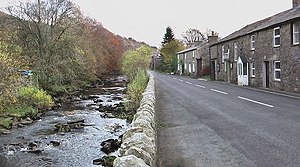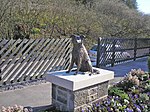Garsdale

Garsdale is a steeply incised dale in the Pennine moorlands of the north-west of the West Riding of Yorkshire, on the western slopes of the Pennines, between Baugh Fell to the north, and Rise Hill to the south. It is within the Yorkshire Dales National Park.
The dale is the valley of the Clough River, which rises on the north eastern slopes of Baugh Fell and flows through Grisedale, as Grisedale Beck until it becomes the Clough River at Garsdale Head.
About the dale
- Location map: 54°18’0"N, 2°24’0"W
- Streetmap: SD740894
The dale gives a name to a civil parish which encompasses most of the dale. Hamlets sit along the main Northallerton to Kendal road (the A684) which runs up the dale for seven miles, with frequent bridges in the upper part of the dale. The largest settlement, known as 'The Street', sits six miles east of Sedbergh, and ten miles west of Hawes. The other hamlet in Garsdale is Garsdale Head, also called 'Hawes Junction', the old name for Garsdale railway station, after the former Wensleydale branch on the Settle to Carlisle railway. The population of the parish recorded in the 2001 census was 202, though, many of the 150 houses were recorded as derelict or used as second homes.
At Longstone Fell, locally known, and spoken as Langst'n Fell, the A684 road rises to a well-known view-point looking over the Howgill Fells, and the river descends to Danny Bridge, the site of a seventeenth-century mill on the “old road”, before joining the River Rawthey near Sedbergh. The Sedgwick Trail, named after the well-known geologist Adam Sedgwick runs along the Clough from Danny Bridge and highlights rock features along the Dent Fault.

At Garsdale railway station stands a statue of Ruswarp, a collie dog which belonged to Graham Nuttall, the first Secretary of the Friends of the Settle–Carlisle Line, which was formed to campaign, ultimately successfully, against the proposed closure of the line. (Ruswarp's paw print was put on his own objection as a fare-paying passenger.) In January 1990 Nuttall and Ruswarp went missing in the Welsh mountains, and on 7 April 1990 a lone walker found Nuttall's body, by a mountain stream. Nearby was Ruswarp, so weak that the 14-year-old dog had to be carried off the mountain. He had stayed with his master's body for 11 winter weeks.
Work and worship in the dale
The Church of St John the Baptist, built in 1861 next to the original mediæval church, stands six miles from Sedbergh, between The Street and Garsdale Hall (which was once an inn but is now used as a farm store). There are also three Methodist chapels: Low Smithy and Garsdale Street, both in regular use, and Hawes Junction which has occasional special events. The only other public building in Garsdale is the village hall which was formerly the primary school.
Garsdale has 18 working farms, most of them amalgamating several of the original smallholdings. Because of the high annual rainfall of up to 100 in, crops other than hay and silage are almost impossible, so all farms are stock rearing. Pedigree Swaledale rams occasionally make high prices at Hawes Auction mart.
Outside links
| ("Wikimedia Commons" has material about Garsdale) |
References
- Thompson, Rev. W (1892). Sedbergh, Garsdale & Dent. Original copy available from Kendal public library.
- Thompson, William (1910). Sedbergh, Garsdale And Dent: Peeps At The Past History And Present Condition Of Some Picturesque Yorkshire Dales. Kessinger Publishing. ISBN 978-0-548-83166-3.
